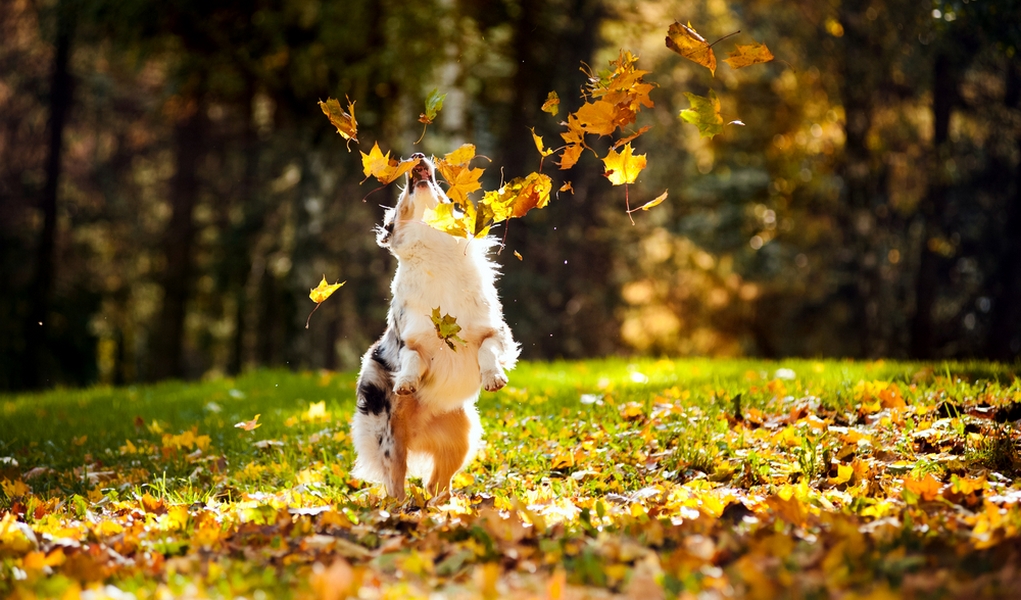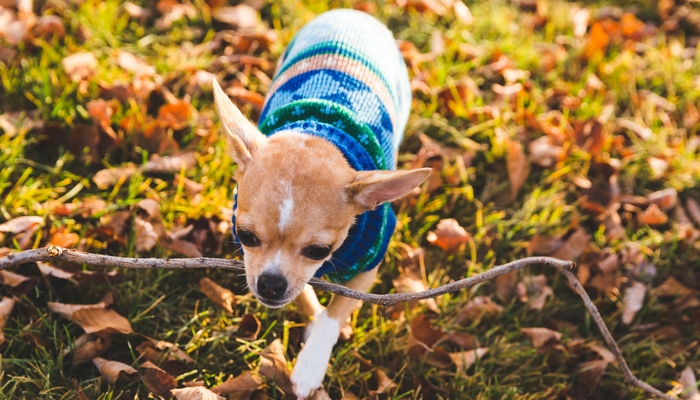Fall is officially here. The weather is getting cooler, the days are getting longer and the foliage is starting to change color here in Maine. Fall brings with it a lot of wonderful things, but there are also some fall dangers for dogs and cats that you should be aware of.
Fall is a great time of year to get outdoors with your pets. The cooler temperatures and lower humidity make it more comfortable outside for us and our furry family members.
While you'll be able to go on longer walks and more outdoor adventures, there are a few things that you should be looking out for. Wildlife, weather and the upcoming holidays can all pose a threat to our pets' health and wellbeing.
8 Fall Dangers for Dogs and Cats
 Rodent Poisons and Pesticides
Rodent Poisons and Pesticides
Most commercial products formulated to keep your home free of spiders, ants, mice and other pests contain toxic chemicals. These pesticides are not only dangerous for our dogs, they are dangerous for humans too!
The use of rodenticides and pesticides becomes more common in the fall. Theses critters are looking for winter homes, which usually brings them into people's houses.
Unfortunately, most pet owners think that toxic chemicals are necessary to rid their homes of pests and parasites. The Environmental Protection Agency (EPA) says that 75% of households in the U.S. use chemical pesticides in their home.
When you use these types of products made with toxic ingredients, the toxins get into the air and on virtually every surface in your home. For example, if traces of these products are on your floors, they will also get onto your pet's paws as he's walking around your home.
It's best to use natural products, like these from Stay Away, or ultrasonic products to keep pests out of your home and away from your yard.
Fall Decorations
Lots of homes dig out the fall decorations this time of year. Whether you're decorating for the season or for one of the many holidays coming up, it's best to strategically place the items where your dog can't reach them.
Alternatively, you can buy and use dog-safe decorations.
Be mindful of wires as well. Keep them secure and out of reach of your pets. Chewing wires could result in electrocution. The safest option is to keep your pet kenneled or in another room when you can't supervise him around holiday decorations.
You also need to be wary of toxic plants, like lilies or chrysanthemums. Natural fall decorations – such as pumpkins, corn stalks and hay bales – will rot over time. Check your natural decorations regularly, and get rid of them when they begin to mold.
Wildlife
Wild animals are also busy preparing for the cold weather, so they are more active this time of year. Be careful on daily walks and hikes.
Snake bites happen more often this time of year. Bear attacks are also more prevalent during the early fall. Small animals can also be dangerous, as they carry a number of diseases.
Wildlife can be attracted to food sources, so be sure to pick up bird feeders, garbage cans and anything else that might draw in hungry animals.
We also cannot forget about ticks. Once the weather starts cooling down, many pet owners think the threat of ticks is over. This is absolutely not true. You should continue protecting your pets against fleas and ticks all year long.
Allergies
Many pet parents believe that the threat of allergies decreases as the seasons change. While a lot of foliage is going into hibernation for the winter, some allergy causing agents are more prevalent in the fall than any other time of year.
Mold, pollen, ragweed, dust, and grass are some of the common culprits of fall allergies in dogs and cats. If your dog suddenly develops a rash and is scratching excessively, sneezing, or has watery eyes and nasal discharge, you should schedule an appointment with your vet.
Allergies in pets are quite common, and they are usually manageable. There are many home remedies for mild cases. If your dog has a severe issue with fall allergies, it's best to contact your veterinarian for help figuring out exactly what the allergen is and how to treat the problem.
Daylight Decreases
Along with colder temperatures, daylight hours decrease during the fall months. With less daylight, it's important that you rearrange your walk schedule to accommodate the change.
If you do have to walk at twilight or after dark, be sure to outfit yourself and your pet with reflective gear. You can also purchase light-up vests, leashes and/or collars to keep yourself and your pets safe.
Changing Routines
Summer can be a hectic time for a lot of families. Kids are home from school, adults take vacation time from work and for many people the summer months are the busiest of the year.
When fall rolls around, routines go back to ‘normal'. Kids go back to school, work schedules go back to normal things begin to settle down.
This change in routine can be difficult for pets. The change is almost instant, and they don't have time to get used to the new routine.
If your pets are going to be alone for longer periods of time, make sure to compensate for that. Take longer walks, make time for longer play sessions or consider hiring a pet sitter. You may also want to consider doggy daycare if you have a high needs dog.
Increase in Traffic
Once your family has settled back in to their regular routine, foot traffic may increase. Children are coming and going from school, adults are coming and going from work and you may have more guests this time of year.
An increase in traffic means more opportunities for your pet to get out of the house unnoticed. Make sure that your guests are aware of your pets. You also need to make sure that your pet has adequate identification.
ID tags are a MUST for all pets. If possible, you should also have your pet microchipped. This will ensure his safe return as quickly as possible if something were to happen.
Holidays
Holidays are something that most people look forward to all year. For pets, they can be a scary time with a lot of confusion.
Make a holiday pet plan in advance. If you're going to be having trick-or-treaters stop by your home, make sure your pet is contained in a safe area. If he has a crate, give him a filled Kong toy or a chew to occupy him and place his crate in a quiet area of your home.
If your pet doesn't have a crate, contain them in a quiet room with a pet gate. This will ensure that your pet won't escape through an open door or become frightened of the children in costumes coming to your door.
Many other holidays involve family gatherings and lots of food. Make a plan to keep your pet safe and comfortable during these events.
If you're going to have a big crowd in your home, make sure your dog has a safe, quiet place to relax. Tell your guests not to feed your dog any human food and explain any rules you have about your pets.
Following these tips will ensure that your dog has a safe and happy fall.
READ NEXT: 11 Tips To Ensure Your Dog Is Safe During the Holidays













